When purchasing cut flowers, or harvesting them yourself, it is important for you to remember that the flower is on a limited lifespan. Cut flowers are no longer attached to a root system, and will perish quickly if not cared for properly. Here, we are going to take a look at some things you can do to get the most out of your cut flowers.
Start off with a Clean Vase
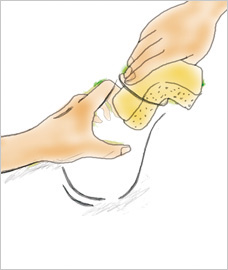 Lingering bacteria and fungi are the enemy, and you don’t want them to contaminate the new water to which new flowers are going to be exposed.
Lingering bacteria and fungi are the enemy, and you don’t want them to contaminate the new water to which new flowers are going to be exposed.
Prepare
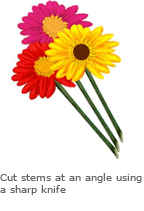 You should re-cut all stems before placing them in the vase. Remove the last 3-5cm of a stem at an angle; do this under water by either cutting in a water-filled basin, or holding the stems and shears under running water. You shouldn’t crush or burn stems, just make clean cuts.
You should re-cut all stems before placing them in the vase. Remove the last 3-5cm of a stem at an angle; do this under water by either cutting in a water-filled basin, or holding the stems and shears under running water. You shouldn’t crush or burn stems, just make clean cuts.
Remove any leaves that are low enough on the stem that they will become immersed in the water.
If you are dealing with a flower like a poppy or poinsettia that has a tendency to ooze a milky fluid, you can extend its vase-life by holding the bottom 5cm of its stem in boiling water for 10 seconds prior to arrangement.
If you plan to use floral foam in your arrangement, be sure to place the foam in the vase and let it sink naturally. If you push floral foam down into the water, it traps air that will shorten the vase-life of your plants.
Water
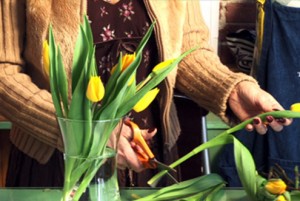 Most flower arrangements begin their collapse early for the reason that they do not get enough water to remain crisp and fresh-looking. Here are a few things you can do to make sure your flowers last longer by getting enough water:
Most flower arrangements begin their collapse early for the reason that they do not get enough water to remain crisp and fresh-looking. Here are a few things you can do to make sure your flowers last longer by getting enough water:
As mentioned above, cut stems under water. This keeps air out of the stems, and keeps the xylem and phloem working more efficiently.
If you notice white deposits around faucets or in kettles, or otherwise know that you have hard water, use de-mineralized water from a supermarket in preparing vase solutions. Don’t use softened water, because it usually contains sodium that could harm cut flowers.
When making a vase solution, use hot water (hot, but not uncomfortable). You should also add some sort of preservative as described below.
Food
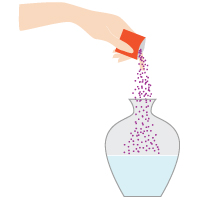 Cut flowers are still living things. They will still require nutrients in order to maintain their colour and overall appearance. Even after they are separated from their root systems, cut flowers can get much of what they need through a vase solution. Here are some suggestions on how to prepare your vase solutions that will help maintain your flowers through improving water flow, supplying nutrients to nurture buds, and inhibiting the growth of unwanted micro-organisms.
Cut flowers are still living things. They will still require nutrients in order to maintain their colour and overall appearance. Even after they are separated from their root systems, cut flowers can get much of what they need through a vase solution. Here are some suggestions on how to prepare your vase solutions that will help maintain your flowers through improving water flow, supplying nutrients to nurture buds, and inhibiting the growth of unwanted micro-organisms.
Lemon-lime soda is a good additive. Using one part soda with three parts water will render a solution that balances sugars and acids to keep the flowers healthy for longer. Don’t use diet sodas, as they don’t have the sugar you want in the solution. Also avoid colas, as these sodas tend to have too much acid. If you want to keep the solution clear, add a very light bleach component. The bleach should only be about 1.25ml per litre.
If you want a more “from-scratch” solution for your flowers, add the following to a litre of warm water: 30ml lemon juice, 15 ml sugar, and 1.25ml bleach. With this solution, you will want to add another 1ml of bleach every 4 days.
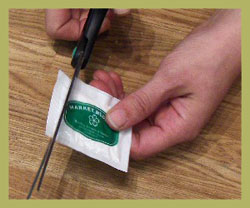 If mixing your own solution isn’t quite your thing, you can always opt for a commercially available flower preservative. Florists and supermarkets will often carry a mix for improving the vase life of flowers. The commercial solutions may not last as long as the given recipes, but they are convenient and inexpensive. Just follow the directions that come with the packaging.
If mixing your own solution isn’t quite your thing, you can always opt for a commercially available flower preservative. Florists and supermarkets will often carry a mix for improving the vase life of flowers. The commercial solutions may not last as long as the given recipes, but they are convenient and inexpensive. Just follow the directions that come with the packaging.
You should take note to avoid using aspirin or vinegar in your vase solutions, as they are not generally effective for increasing the vase-life of flowers.
Treat them well
Flowers will fare better in cool rooms. Higher temperatures will lead to higher rates of degeneration in cut flowers. Avoid putting arrangements where they will be subject to higher ambient heat, such as: in a sunny spot, near heaters, or on heat generating appliances. Properly displaying your arrangement will let the preparation help your cut flowers to last much longer than simply putting them in some water.

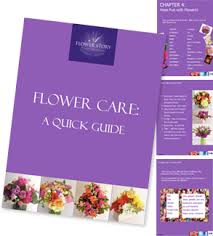
Would appreciate youadvising where cut flower preservative sachets can be purchased inSydney?
Hi there!
My boyfriend and I are German backpacker, travelling through Australia. We are currently looking for farmwork positions where we can do the 88 days of regional work to apply for our second year visa. I wondered if you know any farms that will need some helping hands during the wildflower harvest season that will beginn soon.
We would be happy about any further information and are looking forward to hearing from you.
Best regards.
Mette and Richi
Dear Sir,
I visited your website and learned many useful information. thanks.
Could you kindly please recommend some companies who deals with flower packages? Our company have more than 15years experience in paper packaging, mainly for flower packaging, food packaging.
Many thanks.
Kind regards.
Helen
How do I treat kangaroo paw flowers as cut flowers? They grow really well in my garden, but only last a few days in the vase. I have read that they should last up to 14 days? Appreciate your help.
Wow! This is an excellent tips in cutting a flower. Is it true that a little bleach and lemon can make a cut flower last longer?